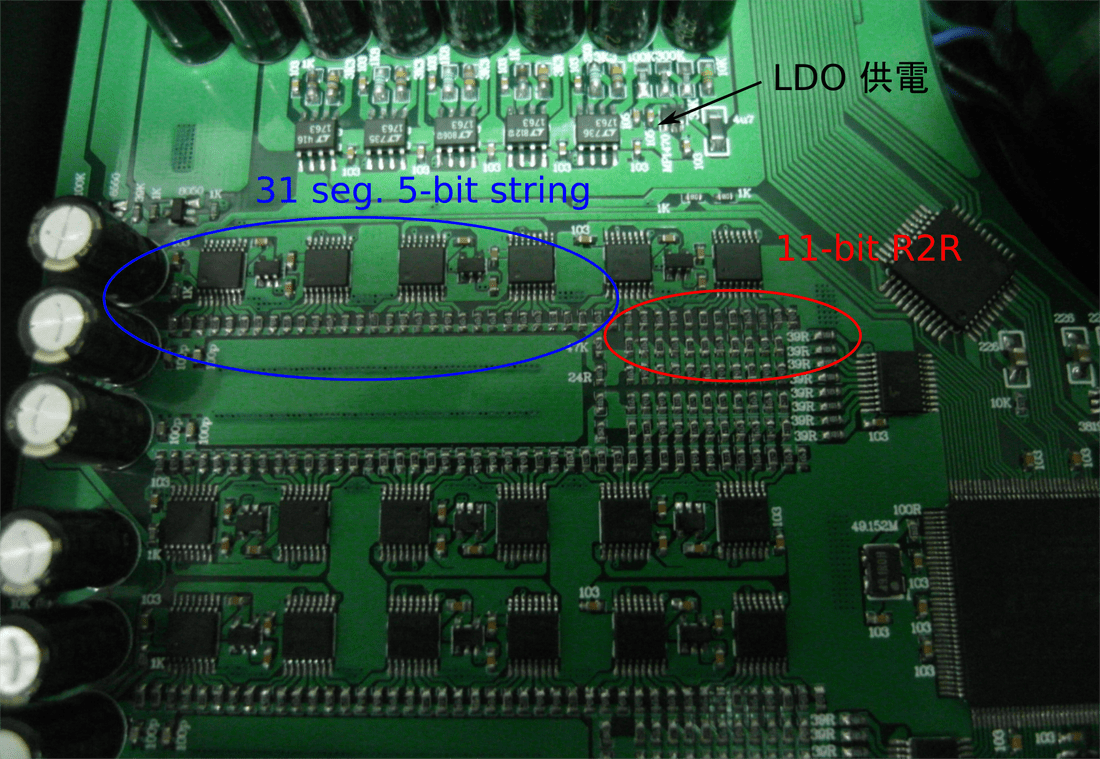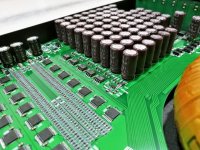ah cool, that's how I did on my dac : one winding by voltage rail; main voltage rail has even its dedicated r-core traffo. And clock has its own winding on a dedicated R-Core traffo; datas and Gnd being isolated from the computer source by isolator chip and fifoted to reduce jitter. It's dead quite and the quantity information than can be heard from a simple 16 bits dac chip can be awesome... But Something is worryng me : Master clock is far from the dac area... more than 10 inches (different boards linked with uf-l wires... huge length maybe as far we talk about digital, even if the length is not all as you pointed out !)
to come back to the topic I saw only the more expensive modelof this new R2R dac brand have Crysteq clocks with very low noise floor...
to come back to the topic I saw only the more expensive modelof this new R2R dac brand have Crysteq clocks with very low noise floor...
Agreed, I don't think I've seen any DAC with an isolated supply for its clock oscillator no matter what the price. This Denafrips looks like a bargain, the cap array certainly impresses me 😀
damned, they did the babel tower caps on an horizontal plane😀 ! Sacrilège !😱
Seems all those caps are more for the photographs and audio porn than mandatory for the sound !
Btw the best equilibrium is not always given by the lowest amount of esr... at least in the old dac chips boards I tweak... but I might be deaf !
I myself don't doubt that all those caps are indeed there for the sound (the bass usually), based on my own experience with similarly sized cap arrays on my DACs. Of course they look macho too which can't harm anything beyond the MTBF and the BOM cost.
yep, marketing proof but not WWF proof !
with such a caps array i will jump to a power dac model in their shoes...
with such a caps array i will jump to a power dac model in their shoes...
For my 1021 V3, replacing the 3.3v 1117 to a tps7a has a positive impact. And I have read that upping the cap near the clock also shows improvement. So maybe the Si nternal regulator is not as good as expected.
My very limited experience on analog, class D and even tubes heater with switcher hasn't been positive, even with added chokes and caps. So my preference is still over linear supply for now and will prefer 60hz hums over hi frequency noise that can cause grain and digital harness. BTW, how does a 60hz magnetic field on digital sound like anyways? I have only heard it over tubes but never on any digital equipment and most tweak for digital is mainly concern on high frequency noise, I believe.
What is failure rate of modern caps anyways? The Chemicon KY used in Ares is rated 4000~10000 hours at 105c, so at lower temperature in the dac, I suspect its closer to 10000 hour.
I agree reclocking can be a good thing, but for some reason, my Soekris doesn't like to be fed high sampling stuff and dsd (at least for my taste I didn't like it) whereas the Ares sound pretty good with upsampled material.
Anyways, owning both the Ares and modified Soekris V3, for my set up and taste, I prefer the Ares as it gives a more musical experience.
My very limited experience on analog, class D and even tubes heater with switcher hasn't been positive, even with added chokes and caps. So my preference is still over linear supply for now and will prefer 60hz hums over hi frequency noise that can cause grain and digital harness. BTW, how does a 60hz magnetic field on digital sound like anyways? I have only heard it over tubes but never on any digital equipment and most tweak for digital is mainly concern on high frequency noise, I believe.
What is failure rate of modern caps anyways? The Chemicon KY used in Ares is rated 4000~10000 hours at 105c, so at lower temperature in the dac, I suspect its closer to 10000 hour.
I agree reclocking can be a good thing, but for some reason, my Soekris doesn't like to be fed high sampling stuff and dsd (at least for my taste I didn't like it) whereas the Ares sound pretty good with upsampled material.
Anyways, owning both the Ares and modified Soekris V3, for my set up and taste, I prefer the Ares as it gives a more musical experience.
First, the Si514 and Si570 clocks have internal regulators, see Silicon Labs AN255 for performance details (The described Si550 use same architecture), so their power supplies are not that critical....
And it's actually easier to filter a little high frequency noise that the huge 50/60 hz magnetic field from a transformer, I have no problems with it at all.
dac1541: High reliability high efficiency switch mode supplies, following by LC filters, following by high speed, ultra low noise, ultra low impedance discrete regulators, a total of six of them. Digital clocks powered by LP5907's.
Most others: Transformers with large magnetic fields, followed by inefficient linear regulators using standard chips, with a shitload of unreliable electrolytic capacitors trying to fix things....
So which one is the smart way of designing and will work like new after ten years of service ?
And btw, you do know that the Ares do not have a reclocking fifo, so the 50 pS jitter from the AK4118 spdif receiver goes right though the DAC ?
Last edited:
What is failure rate of modern caps anyways? The Nichicon KY used in Ares is rated 4000~10000 hours at 105c, so at lower temperature in the dac, I suspect its closer to 10000 hour.
Lifetimes of caps double for every 10oC fall in temperature. So if you were to get 4000hrs at 105oC that would translate to 32X as long (128,000hrs) at 55oC.
According to someone, the Denafrips is a 31 seg. 5bit string + 11bit R2R design. However, it has considerable glitches. On low level signal, the glitches could be as high as 10mv.




LTC2642
What Data format does the LTC accept? I2S?
Thanks,
P.
But industorial DACs ,for example LTC2642 etc, are availeble....
What Data format does the LTC accept? I2S?
Thanks,
P.
That doesn't looked like the Ares as it has 7 shift register on each row while your photo shows 6. The Ares spec also claim to have 20bits. Could it be the older version of Denafrips dac?
" Ares employees 20BIT R2R + 6BIT DSD (32 steps FIR Filters), native PCM & DSD decoding with 0.01% precision resistors."
" Ares employees 20BIT R2R + 6BIT DSD (32 steps FIR Filters), native PCM & DSD decoding with 0.01% precision resistors."
According to someone, the Denafrips is a 31 seg. 5bit string + 11bit R2R design. However, it has considerable glitches. On low level signal, the glitches could be as high as 10mv.


Attachments
Its interface is SPI, rather like a mono version of I2S.
So if just feed it i2s with separate left right data it would sing?
Its interface is SPI, rather like a mono version of I2S.
Thanks, so a bit like what you would feed a TDA1540?
P.
Thanks, so a bit like what you would feed a TDA1540?
From a quick eyeball of the TDA1540 DS, indeed yes there is a remarkable similarity.
@ChuckT - I2S's WS isn't directly compatible even after you manage to separate out the data. Probably you'd need a few flip-flops and gates to generate a single-cycle long LE signal each time the WS transitions.
That doesn't looked like the Ares as it has 7 shift register on each row while your photo shows 6. The Ares spec also claim to have 20bits. Could it be the older version of Denafrips dac?
" Ares employees 20BIT R2R + 6BIT DSD (32 steps FIR Filters), native PCM & DSD decoding with 0.01% precision resistors."
Could be others. The designer has several similar products. A 20bit R2R DAC is not easy to maintain its linearity due to insufficient resistor accuracy.
Denafrips has a ToTL model called 'Terminator' which uses 0.005% resistors I believe. However even such precision only gets to around 14bits.
But the Soekris has 0.05 or 0.012 % precision résistors ? Is it because the chips around are différent ?
The Soekris is subject to the same mathematics as every other resistor-based DAC. It seems the old-school DAC specs (INL, DNL) aren't so relevant to sound quality as once thought.
... I'm asking myself how is the precision of the naked Vishay resistor in a Total Dac; résistors are sorted out, first price is 4 000 euros !
Me go back to my TDA1540...
Me go back to my TDA1540...
It would be an interesting (although of course completely heretical) experiment to replace all those naked Vishays with Susumu 0.1% el-cheapo thin films and see how it sounds....
- Home
- Source & Line
- Digital Line Level
- Denafrips discrete R2R Multibit
